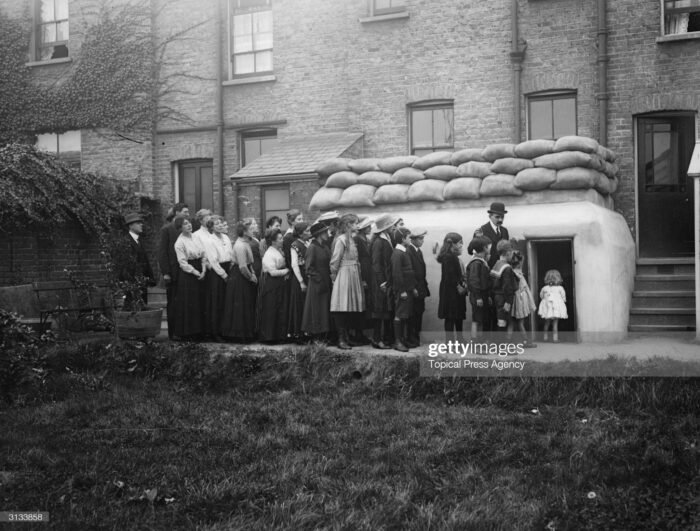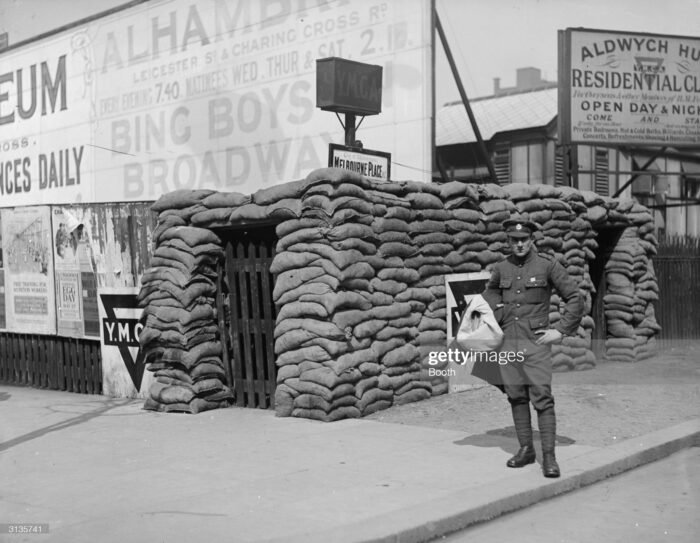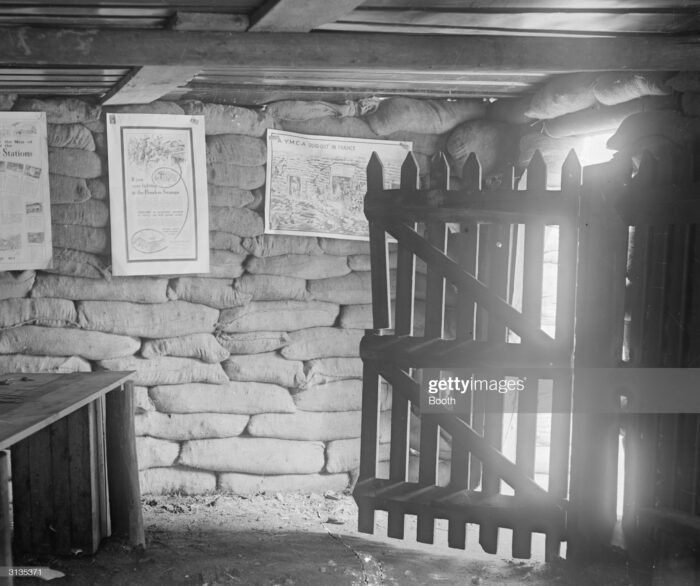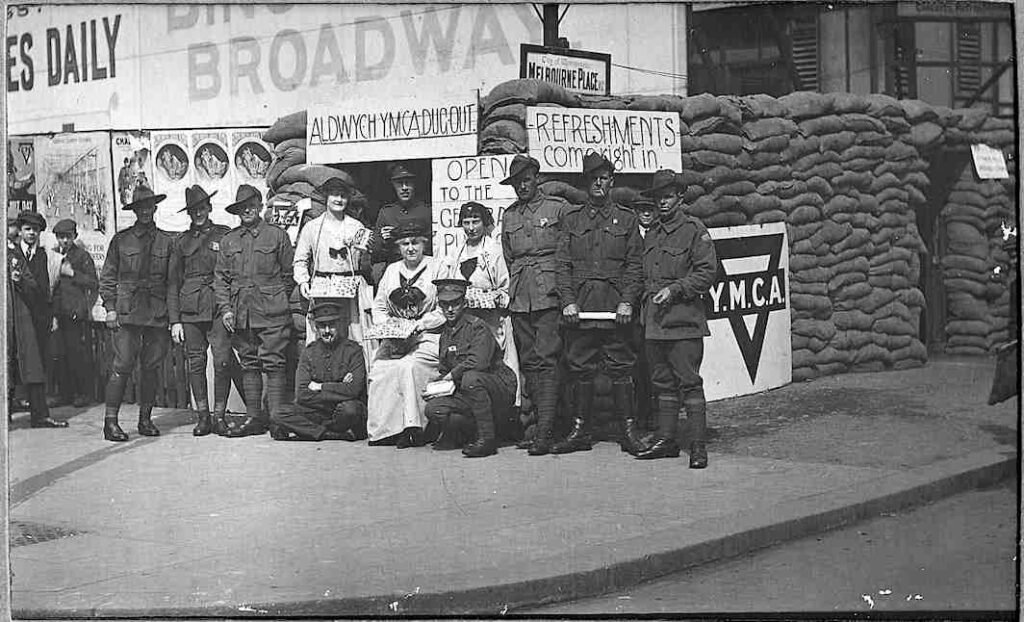
Recently, Alexandra Churchill tweeted a photo of an air raid shelter in London in 1917:
She’s absolutely right, and I’ll eventually come back to this, sort of; but Rob Langham made a slightly different point which I want to follow up first:
That’s an incredible photo for many reasons. @IanCastleRaids @ZeppRaider and @StowAero will likely all marvel at the air raid shelter as I am!
— Rob Langham (@RailRamblings) February 4, 2021
Indeed, in my experience it is very rare indeed to find images of any raid shelters from the First World War. This, of course, is largely because they were far less common than in the Second World War, when the expected scale of attack was much larger and the time of preparation much longer, leading to many shelters being built in streets, schools and private homes from the late 1930s onwards — and that’s even before you get to the millions of backyard Anderson shelters. Quite a number of these still survive, just through sheer prevalance. By contrast, there’s one First World War survivor at Woodbridge in Suffolk (c. 1915), and not much else.1 So it is useful to have some photographic evidence, too.
I’ve managed to find a handful of other images of the Hither Green shelter, along with a little information. Getty Images has three, all dated to October 1917. The first, at the top of the post, is the one shared on Twitter, described as ‘An Indian family standing by their air raid shelter at their home in Hither Green’.

Then there is ‘Residents outside their communal air raid shelter in Hither Green, south-east London, October 1917’.

While this one is described as ‘A crowd lining up to enter an air raid shelter at Hither Green’.
All three photos are clearly taken at the same time, probably an event staged for a press photographer. There are many more people in the second and third photos, along with the family from the first photo; presumably these are local residents. One caption describes the shelter as belonging to the family; another says it’s ‘communal’. Both could be true, I suppose, but unless the concrete structure extends into a cellar it’s going to be pretty cramped with all those people inside. Unfortunately we don’t get a view inside; but there is one more image.

This is from the Graphic, under the headline ‘WHY NOT MAKE YOUR OWN DUG-OUT? AN ENGLISHMAN’S HOME AS A BOMB-PROOF SHELTER’.2 The accompanying article reads:
If London is in the war-zone, why not act accordingly? One Londoner, at least, has had the nous to do so. At his suburban house at Hither Green a City merchant has built a bomb-proof shelter to accommodate his family and friends during air raids. This dug-out, constructed on the approved front-line model, is made of reinforced concrete 3½ feet thick, and the roof, of steel girders, is further protected with sandbags. It is fitted with electric light and is sunk two feet in the ground. The total cost was only £50, and a shelter of this description can be made in any back garden.3
This tells us that the man is ‘a City merchant’, but doesn’t mention his presumed wife and daughters, nor does it tell us anything specific about the location of the shelter. I suspect this photo was taken on the same occasion as the other three, but even if it wasn’t the fact that it was published in September means that the shelter was built before (and therefore not because of) Hither Green suffered a serious raid on the night of 19 October 1917, killing fourteen people. Hopefully, the shelter served its purpose.
While I was searching through Getty Images for the Hither Green shelter, I found a few other interesting images relating to civilian air raid shelters from the First World War, so I thought I’d mine them to see what turned up.4

This one is dated to 17 July 1917, so just after the big daylight Gotha raids; where is not specified, but probably somewhere in London. No shelter is actually visible here, but the notice being read by the woman and children reads
THIS HOUSE
contains a fairly good sized
CELLAR,
in the event of an
AIR RAID
passers by are welcome to what shelter it affords.
Again, the suggestion here is that some shelters were being built privately, but at least sometimes are acting as public shelters.
Then there are three photos, from here, here, and here, of a YMCA air raid shelter on the Strand, all dating from January or May 1918.

The location, as can be here, is on the corner of Melbourne Place, so just across from (the then brand-new) Australia House. It turns out that this shelter was just one corner of the YMCA’s Aldwych Hut, which was a club for Australian servicemen — logically enough, given the location.

Two women, with many mugs; the sign is missing from the first image but it looks like the same arrangement of sandbags around the rear door.

Inside it’s pretty bare, and not very inviting.
I’m actually not convinced that this was a ‘real’ air raid shelter, as opposed to a way to raise funds from passers-by. Getty Images does describe all three photos as being of an ‘air raid shelter’ (which is how I found them), but there seems to be no sign saying it’s a shelter.

I found this undated, photo of the ‘shelter’ in a selection of photos belonging to J. J. Percival Curnow, the manager of the Aldwych Hut. The sign above the door says ‘ALDWYCH YMCA DUG-OUT’ and next to that is one saying ‘REFRESHMENTS COME RIGHT IN’. It seems more likely to me that rather than being an air raid shelter, it was meant to evoke a trench shelter, as a way to pull people off the street and to part them from their money (for a good cause, of course). That would explain the many mugs as well as the posters about YMCA dug-outs in France and so on. Still, if you happened to be walking down the Strand when an air raid was on, you probably wouldn’t stop to ask questions!
So far, so-so. There doesn’t seem to be much photographic evidence of First World War air raid shelters at all, at least not where I’m looking. But a final pair of photos held by Getty Images, while not showing any air raid shelter at all, are nevertheless very intriguing indeed.

This one is dated 17 October 1917 and are described as ‘Moses Shackman, centre, with members of the Jewish East End Shelter Corps. Their hats are labelled in Yiddish and English’. I haven’t been able to trace Moses Shackman.

This one has exactly the same date and caption, but it clearly shows that the hatbands in fact read, in English, ‘RAID SHELTER CORPS’. There are a few hits in the British Newspaper Archive about an organisation with this name, and it was based in Stepney. Since Stepney had a large Jewish population at this time, that would seem to fit. But the story seems to be more complicated than that — so I’ll take it up in another post.
![]() This work is licensed under a Creative Commons Attribution-NonCommercial-NoDerivatives 4.0 International License.
Permissions beyond the scope of this license may be available at http://airminded.org/copyright/.
This work is licensed under a Creative Commons Attribution-NonCommercial-NoDerivatives 4.0 International License.
Permissions beyond the scope of this license may be available at http://airminded.org/copyright/.
- The Historic England page for the Woodbridge shelter says it is ‘one of only two purpose-built First World War air raid shelters known to survive in England’, but rather unhelpfully doesn’t actually say where the other one is. It might be at the Great Wakering Old School in Essex, according to a site which is currently offline. Update: Ian Castle pointed out that the ‘other’ surviving shelter is probably the one at Cleethorpes in Lincolnshire (built in 1916). [↩]
- Graphic, 29 September 1917, 375. [↩]
- Ibid. [↩]
- I’m only looking at the British ones here, but there are also some from France and Belgium, including one from February 1918 where some of the occupants appear to be wearing gas masks. [↩]





That first photo of the Indian family feeds beautifully into this alt-history novel I’m been long grappling with and now closing in on the sixth draft. Could I send you a tech-heavy chapter? I’d welcome your opinion on whether I’m getting the vibe right for an electropunk world where 1920s European empires got reverse colonised, electricity is being rolled out on religious lines and no one has yet invented heavier than air flying machines.
Nabakov:
Sorry for the late reply, but (a) glad if this post helps inspire you and (b) yes, please do!
Hey, my brother just came across these photos of my great grand-parents whilst he was doing a search of ‘bunkers’ in London looking for info on my grand-mother !
That “Indian Merchant’s Family” is actually my grand-mother (from my mother’s side). She’s the little one on the extreme right !
The “Indian Merchant” was my great-grandfather Ratanji Desai. He was a Parsi Zoroastrian by faith. Much later they all came back to Bombay, India. And the rest is history … my family history !
Sorry … the full name is Rustamji Ruttanji Desai.
Thanks so much for this, Thrity! How amazing to be able to find your great-grandparents and grandmother in these old photos this way.
Having your great-grandfather’s name helps me narrow down the location of the shelter. From the 1911 census I can see that they were living at 13 Minard Rd, Hither Green, so that’s a possibility. But a newspaper article from 1924 has him living at Wellmeadow Rd, Hither Green (no house number). Since 1917 is almost in the middle I wouldn’t like to guess which it was, though. Do you happen to happen to know? It sounds like your family recalls the air raid shelter (since your brother was looking for bunker photos) – do you happen to have any other information about the shelter or, when and why they built it? I understand if you don’t have or don’t want to provide more information; thanks for the name, that’s brilliant.